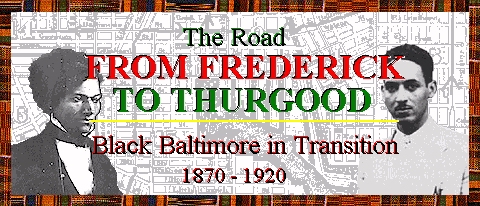 |
West Baltimore |
 |
West Baltimore |
The years following the Civil War saw rapid expansion of urban life beyond the old city core. New forms of transportation (horsecars, then electric trolleys) transformed relatively quiet streets into busy corridors of commuters. Streetcars carried people northwest along Pennsylvania, Druid Hill, and Madison Avenues to new townhouses. The city center had become so crowded that people were starved for space and with the advent of mass transport found it possible to live further away from downtown jobs. The burgeoning black middle class joined European immigrants and their descendants in the quest for the good life. In the instance of the West Baltimore neighborhood, African-Americans joined and ultimately replaced German Jews, whose faster rate of upward mobility sent them further out to even more spacious areas. The tendency of the more affluent to live further away from downtown is evident even within the black community of West Baltimore itself: while civic leaders and successful businessmen occupied fine homes on leafy blocks near the outskirts of town, the cramped section of the neighborhood surrounded by Pennsylvania and Druid Hill avenues and Biddle and Preston streets was so unhealthy that it would come to be known as "Lung Block" during the tuberculosis epidemic following the first World War. 1
The area roughly bounded by North Avenue, Eutaw Place, Calhoun Street and Lafayette Avenue became home to Baltimore's most influential African-Americans in the decades surrounding the turn of the century. This West Baltimore neighborhood replaced the East Baltimore area near Fells Point as the heart of the city's black community. While Frederick Douglass, nineteenth century Baltimore's most famous product, was raised on the east side of town, his counterpart in the twentieth century, Thurgood Marshall, grew up in West Baltimore.
A great number of black immigrants arriving from the South during Reconstruction and after made West Baltimore their prime locus of settlement, and they eventually outnumbered native Baltimoreans who traced their origins to East Baltimore. They often encountered opposition from white residents, who turned to their legislators with hopes of "preserving" their neighborhoods. Residential segregation laws enacted by Baltimore lawmakers faced several tests in West Baltimore and eventually fell by the wayside. Ordinances of 1910, 1911 and 1913 were fought in court by W. Ashbie Hawkins and Warner T. McGuinn, residents of the area, and were struck down each time. George W. F. McMechen, a lawyer and community leader, was among those initially denied the right to settle there, but he eventually won his case and moved in.
Churches, in addition to cultivating the spiritual lives of their congregants, functioned as community meeting-places and breeding grounds for political movements. The most influential churches in this neighborhood included Sharon Baptist, founded by William M. Alexander in 1885; Union Baptist, pastored by Harvey Johnson; and Bethel AME.
Political power became a reality for West Baltimore's African-Americans in 1890 with the election of Harry S. Cummings to the City Council. Representing Ward 11, Cummings succeeded in obtaining neighborhood improvements and paved the way for other black leaders including McGuinn and GeorgeM. Lane, Baltimore's first African-American mayoral candidate and also a West Baltimore resident. Roberta B. Sheridan one of Baltimore City's first African American teachers and a beneficiary of the efforts of political leaders, resided in West Baltimore in the early twentieth century.
![]() Return to The Road
From Frederick To Thurgood Introduction
Return to The Road
From Frederick To Thurgood Introduction
|
Tell Us What You Think About the Maryland State Archives Website!
|
© Copyright December 06, 2012 Maryland State Archives